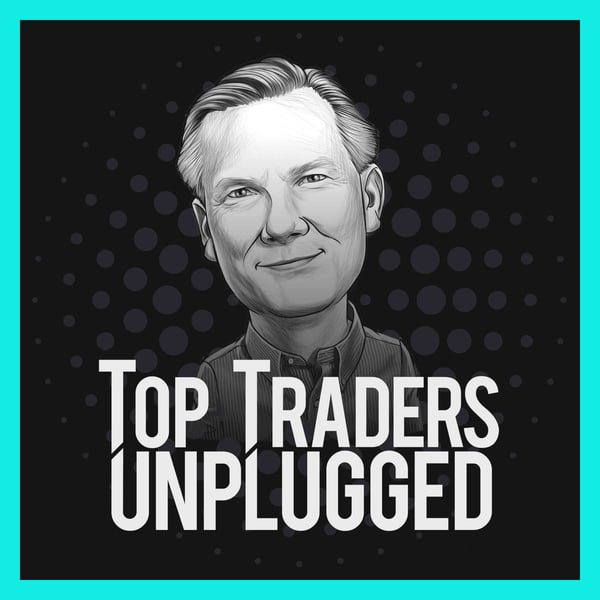TTU40: What To Do If You Are Making Too Much Money! ft. Mike Harris of Campbell & Company – 2of2
Top Traders Unplugged
Niels Kaastrup-Larsen
4.8 • 670 Ratings
🗓️ 30 October 2014
⏱️ 70 minutes
🧾️ Download transcript
Summary
Welcome to Part 2 of our conversation with Managed Futures expert and President Mike Harris of Campbell & Company. In this episode we delve into the specifics of Campbell & Company’s trading programs, how models are added or removed, and the importance of risk management. This episode also explores the managed futures industry as a whole and is a must-hear for anyone looking to gain knowledge about this strategy.
-----
50 YEARS OF TREND FOLLOWING BOOK AND BEHIND-THE-SCENES VIDEO FOR ACCREDITED INVESTORS - CLICK HERE
In This Episode, You’ll Learn:
- About Campbell & Company’s trading program.
- How they create a trading strategy.
- Why they use a hypothesis driven system to add new models to their programs.
- About the peer review process they use before adding or subtracting models.
- When do you remove a model? How do you know when it isn’t working anymore?
- About position sizing and why its important.
- How they look at risk through something called Vertical Risk and Horizontal risk.
- Campbell’s systematic approach to risk management.
- How he deals with drawdowns.
- Why he worries about systemic risk and natural disasters.
- Why Mike thinks redundancies are so important.
- The risk of regulation.
- How these strategies tend to perform when interest rates go up.
- The trend of the managed futures industry and why it has been dominated by European firms in the past 10 years.
- What people need to become a successful manager: humility is “at the top of the list.”
- Books that Mike recommends.
- What he would do differently if he could talk to his younger self.
- The importance of managing work and life balance.
- What the future looks like for Campbell & Company.
-----
Resources & Links Mentioned in this Episode:
- Learn more about Baltimore and Johns Hopkins University.
- Hedge Fund Market Wizards by Jack Schwager
- Technical Analysis of the Futures Markets by John Murphy
- Trend Following with Managed Futures
Follow Niels on Twitter, LinkedIn, YouTube or via the TTU website.
IT’s TRUE ? – most CIO’s read 50+ books each year – get your FREE copy of the Ultimate Guide to the Best Investment Books ever written here.
And you can get a free copy of my latest book “Ten Reasons to Add Trend Following to Your Portfolio”
Transcript
Click on a timestamp to play from that location
| 0:00.0 | You're listening to Top Traders Unplugged, episode number 040, where I continue my conversation with Mike Harris, president of Campbell and Company. |
| 0:10.2 | This episode is sponsored by Swiss Financial Services. |
| 0:14.4 | Welcome back to Top Traders Unplugged, where the best traders in the world come to share their experiences, their successes, and their failures. |
| 0:22.4 | Let's rejoin the conversation with your host, veteran hedge fund manager, Niels Kastrop Larson. |
| 0:57.3 | I wanted to talk a little bit more about the trading program and in some ways I wanted to give you kind of the opportunity to take us where you want in terms of describing or what you want to mention about the trading program and so on and so forth. But I want to mention one thing that I noticed that I think is certainly |
| 1:03.1 | an interesting topic and maybe that's something you want to, you know, comment on. And that is |
| 1:08.1 | how you create a strategy because, you you know maybe it's a bit difficult for |
| 1:14.1 | many people to really understand how cta's work some people look at data create strategies from |
| 1:19.8 | there but you actually look at it from a slightly different point of view you look at ideas |
| 1:24.2 | and then you find ways of turning that into strategies, if I'm not mistaken. |
| 1:28.6 | So maybe that's a starting point. |
| 1:30.8 | But feel free to talk about the managed futures program and how you would really help people understand it. |
| 1:40.2 | Yeah, I mean, I think that your comment about the way we approach research is really key to understanding our strategies and how we come up with them. |
| 1:50.3 | So at our core, we're really hypothesis-driven. |
| 1:54.1 | You know, we start the day with what we call an intuitive investment thesis. |
| 1:58.0 | So somebody in the research process comes up with an idea that's based on a theory |
| 2:03.2 | of economics or financial markets. And then from there, we use the data in our science to |
| 2:10.3 | effectively codify that investment thesis. We then run obviously the back tests. We optimize. |
| 2:16.7 | We work to make improvements to it. |
| 2:19.1 | And then only at that point does the research team, we've got five teams in research. |
| 2:24.7 | That team will effectively, even though, as I said, to protect against keyman risk, one individual may have come up with that idea. |
| 2:31.6 | You know, it's quickly embraced by the team. |
... |
Please login to see the full transcript.
Disclaimer: The podcast and artwork embedded on this page are from Niels Kaastrup-Larsen, and are the property of its owner and not affiliated with or endorsed by Tapesearch.
Generated transcripts are the property of Niels Kaastrup-Larsen and are distributed freely under the Fair Use doctrine. Transcripts generated by Tapesearch are not guaranteed to be accurate.
Copyright © Tapesearch 2025.

